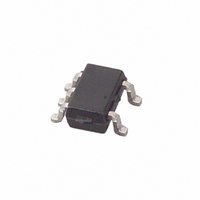MAX9075EXK+T Maxim Integrated Products, MAX9075EXK+T Datasheet - Page 6

MAX9075EXK+T
Manufacturer Part Number
MAX9075EXK+T
Description
IC COMPARATOR SNGL SC70-5
Manufacturer
Maxim Integrated Products
Type
General Purposer
Datasheet
1.MAX9075EUKT.pdf
(8 pages)
Specifications of MAX9075EXK+T
Number Of Elements
1
Output Type
CMOS, Push-Pull, Rail-to-Rail, TTL
Voltage - Supply
2.1 V ~ 5.5 V
Mounting Type
Surface Mount
Package / Case
6-TSSOP (5 lead), SC-88A, SOT-353
Number Of Channels
1 Channel
Product
Digital Comparators
Offset Voltage (max)
+/- 8 mV
Input Bias Current (max)
- 20 nA
Supply Voltage (max)
5.5 V
Supply Voltage (min)
2.1 V
Supply Current (max)
6.6 uA
Maximum Power Dissipation
200 mW
Maximum Operating Temperature
+ 85 C
Mounting Style
SMD/SMT
Minimum Operating Temperature
- 40 C
Comparator Type
General Purpose
No. Of Comparators
1
Response Time
580ns
Ic Output Type
CMOS, Push Pull, TTL
Supply Current
3µA
Supply Voltage Range
2.1V To 5.5V
Rohs Compliant
Yes
Lead Free Status / RoHS Status
Lead free / RoHS Compliant
Other names
MAX9075EXK+T
MAX9075EXK+TTR
MAX9075EXK+TTR
Low-Cost, Ultra-Small, 3µA
Single-Supply Comparators
The MAX9075/MAX9077 feature a 580ns propagation
delay from an ultra-low supply current of only 3µA per
comparator. These devices are capable of single-sup-
ply operation in the 2.1V to 5.5V range. Large internal
output drivers allow rail-to-rail output swing with up to
2mA loads. Both comparators offer a push-pull output
that sinks and sources current.
The MAX9075/MAX9077 are designed to maintain a
low-supply current during repeated transitions by limit-
ing the shoot-through current.
The input common-mode voltage range for these
devices extends from -0.2V to V
other comparators, the MAX9075/MAX9077 can oper-
ate at any differential input voltage within these limits.
Input bias current is typically -5nA if the input voltage is
between the supply rails.
Although the comparators have a very high gain, useful
gain is limited by noise. The comparator has a wide-
band peak-to-peak noise of approximately 70µV.
6
SOT23
Noise Considerations, Comparator Input
_______________________________________________________________________________________
—
—
—
—
—
—
1
2
3
4
5
MAX9075
SC70
—
—
—
—
—
—
1
2
3
4
5
PIN
µMAX/SO
Detailed Description
—
—
—
1
4
3
2
8
5
6
7
MAX9077
Comparator Output
CC
SOT23
- 1.2V. Unlike many
—
—
—
1
2
4
3
8
5
6
7
NAME
OUTA
OUTB
GND
INA+
INB+
OUT
INA-
INB-
V
IN+
IN-
CC
Hysteresis extends the comparator’s noise margin by
increasing the upper threshold and decreasing the
lower threshold. A voltage divider from the output of the
comparator sets the trip voltage. Therefore, the trip
voltage is related to the output voltage. Set the hystere-
sis with three resistors using positive feedback, as
shown in Figure 1.
The design procedure is as follows:
1) Choose R3. The leakage current of IN+ may cause a
2) Choose the hysteresis voltage (V
3) Calculate R1 as follows:
Comparator Output
Output of Comparator A
Ground
Noninverting Comparator Input
Noninverting Input of Comparator A
Inverting Comparator Input
Inverting Input of Comparator A
Positive Supply Voltage
Noninverting Input of Comparator B
Inverting Input of Comparator B
Output of Comparator B
small error; however, the current through R3 can be
approximately 500nA and still maintain accuracy.
The added supply current due to the circuit at the
trip point is V
for R3, as this keeps the current well below the sup-
ply current of the chip.
voltage between the upper and lower thresholds. In
this example, choose V
V
R1 = R3 x V
REF
= 1.2V and V
HYS
Applications Information
CC
/R3; 10MΩ is a good practical value
/ V
CC
CC
FUNCTION
= 5V.
= 10MΩ x 0.05 / 5 = 100kΩ
HYS
Pin Description
Adding Hysteresis
= 50mV and assume
HYS
), which is the








